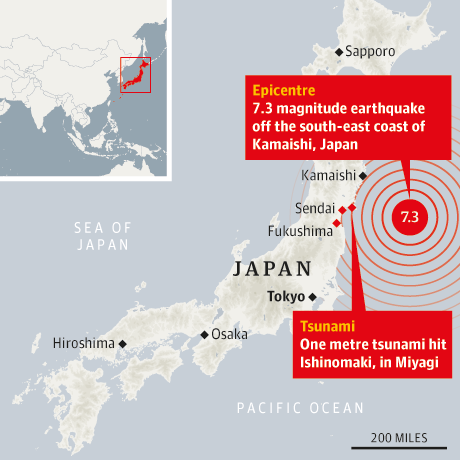Japan escaped largely unscathed on Friday after a magnitude 7.3 earthquake shook the north-east coast. It was, however, a chilling reminder of the 9.0 quake that struck the area in March 2011, triggering a tsunami that killed almost 20,000 people and a triple meltdown at the nearby Fukushima Daiichi nuclear power plant.
Initially, the appearance on TV screens of a tsunami warning, and repeated announcements to remember last year's tragedy and flee the coast, prompted fears of a second disaster in less than two years in the worst-affected prefectures of Iwate, Miyagi and Fukushima.
Less than an hour later, a tsunami washed ashore in Ishinomaki, one of the hardest-hit towns in last year's tragedy, where the rebuilding process has barely begun. Mercifully, this time the wave was just a metre high. Two hours after the quake struck 150 miles offshore at 5:18pm local time, the meteorological agency cancelled its tsunami warning.
Narita airport closed briefly for safety checks and phone lines were temporarily jammed by the large volume of calls. Several, much smaller, tsunamis lashed other parts of the coast, including Soma city, which lies just outside the 12-mile (20km) evacuation zone imposed around the Fukushima plant.
 Map showing where the earthquake struck
Map showing where the earthquake struck
On Friday, as on 11 March 2011, the earthquake appeared to have cause minimal damage – testimony to the unrivalled ability of specially designed Japanese buildings to withstand violent seismic activity that could potentially kill thousands in many other countries.
Buildings swayed for several minutes as far away as Tokyo; nearer the epicentre, where coastal towns and villages are largely deserted swaths of flattened land, people fled to higher ground. For all the relief that catastrophe had been diverted, Friday's earthquake would have added to the anxieties of the 325,000 people in the region still living in temporary accommodation.
"I was in the centre of the city the very moment the earthquake struck," Chikako Iwai, a resident of Ishinomaki, told Reuters. "I immediately jumped into the car and started running towards the mountains. I'm still hiding inside the car. I have the radio on and they say the cars are still stuck in the traffic. I'm planning to stay here for the next couple of hours."
Thoughts quickly turned to the Fukushima plant, declared stable by authorities a year ago but where workers have yet to begin the dangerous task of removing molten fuel from damaged reactors and the long, costly process of decommissioning.
The plant's operator, Tokyo Electric Power, said workers had been ordered to shelter inside buildings around the plant, but added that there was no sign of damage or radiation leaks.
Police reported that five people had been injured, including a 75-year-old woman who fell while heading for higher ground.
Thanks to Japan's warning system, people in the area had up to six minutes to take precautions between the first estimate of the quake's intensity and the moment it struck.
The earthquake measured a lower five in Miyagi prefecture on Japan's scale of one to seven, which measures the amount of shaking a quake causes rather than its intensity.
Earthquakes of that strength can damage older buildings and roads, which do not have the strict quake-resistant features introduced after more than 6,000 people died in an earthquake in Kobe, in January 1995.http://www.guardian.co.uk/world/2012/dec/07/japan-earthquake-tsunami-fukushima-fears
No comments:
Post a Comment